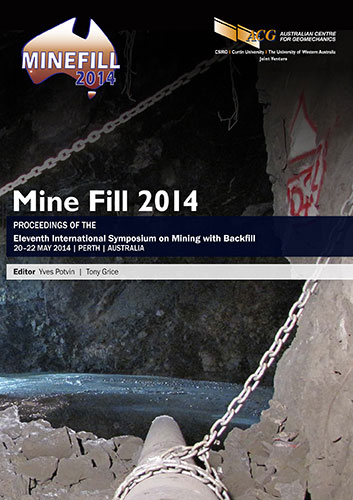Fill design and implementation with challenging material – Wambo fill project – case study

|
Authors: Helinski, M; Revell, MB |
DOI https://doi.org/10.36487/ACG_rep/1404_33_Helinski
Cite As:
Helinski, M & Revell, MB 2014, 'Fill design and implementation with challenging material – Wambo fill project – case study', in Y Potvin & T Grice (eds), Mine Fill 2014: Proceedings of the Eleventh International Symposium on Mining with Backfill, Australian Centre for Geomechanics, Perth, pp. 421-438, https://doi.org/10.36487/ACG_rep/1404_33_Helinski
Abstract:
Peabody Energy is the world’s largest private sector coal company and a global leader in sustainable mining and clean coal solutions. The company serves metallurgical and thermal coal customers in more than 25 countries on six continents and has mining operations across Queensland and New South Wales. Peabody’s Wambo Coal Mine is a longwall mining operation located in the Hunter Valley Region of NSW, Australia. Longwall mining activities are ongoing in the Wambo coal seam. Overlying a section of the underground operations (at the surface) is an alluvial channel that hosts an important water course for the area. Abandoned ‘board and pillar’ workings exist approximately half way between the Wambo seam and the surface. These workings (referred to as the ‘Homestead workings’) are within the Whybrow seam and when previously mining this area very poor ground conditions were experienced. Peabody identified a risk of sink holes forming, between the Homestead workings and the surface, during longwall extraction of the underlying section of the Wambo seam. The perceived sinkhole formation was recognised as having the potential to ‘break’ the surface aquifer, resulting in a significant environmental impact as well as jeopardising the safety and productivity of the longwall operations. This paper presents the design and implementation of a novel cost effective strategy for filling these workings. The old workings in the Whybrow seam, requiring fill, consisted of approximately 15 km of roadway, spread over an area of approximately three hectares, involving more than 100 boreholes. The most appropriate material available onsite was a natural alluvial soil. However, the variable nature of this material presented a number of challenges Furthermore, the fill material was to be exposed to a unique set of loading conditions. This paper details test work and analysis strategies employed to ensure that the fill requirements were satisfied. The results are then converted into a flexible framework that facilitates cost effective filling, while ensuring that the design requirements are maintained for the range of different fill source materials. Finally, this paper describes the implementation of the fill solution, presenting useful data collected during the operation and highlighting aspects of the project that worked well and those that posed additional challenges.
References:
Been, K & Jefferies, MG 1985, ‘A state parameter for sands’, Géotechnique, vol. 35, no. 2, pp. 99-112.
Clough, G, Iwabuchi, N & Kuppusamy, T 1989, ‘Influence of Cementation on Liquefaction of Sands’, Journal of Geotechnical Engineering, vol. 115, no. 8, pp. 1102-17.
Fourie, AB, Blight, GE & Papageorgiou, G 2001, ‘Static liquefaction as a possible explanation for the Merriespruit tailings dam failure’, Canadian Geotechnical Journal, vol. 38, no. 4, pp. 707-19, 10.1139/t00-112.
Golder Associates 2013, Report Number: 04-003-WBO-100, prepared by Golder Associates for Peabody Energy.
Kramer, SL 1996, Geotechnical Earthquake Engineering, Prentice Hall, Upper Saddle River, New Jersey.
Terzaghi, K & Peck, RB 1967, Soil mechanics in engineering practice, John Wiley and Sons, New York, New York.
Zhang, H & Garga, VK 1997, ‘Quasi-steady state: a real behaviour?’, Canadian Geotechnical Journal, vol. 34, no. 5, pp. 749-61.
© Copyright 2026, Australian Centre for Geomechanics (ACG), The University of Western Australia. All rights reserved.
View copyright/legal information
Please direct any queries or error reports to repository-acg@uwa.edu.au
View copyright/legal information
Please direct any queries or error reports to repository-acg@uwa.edu.au